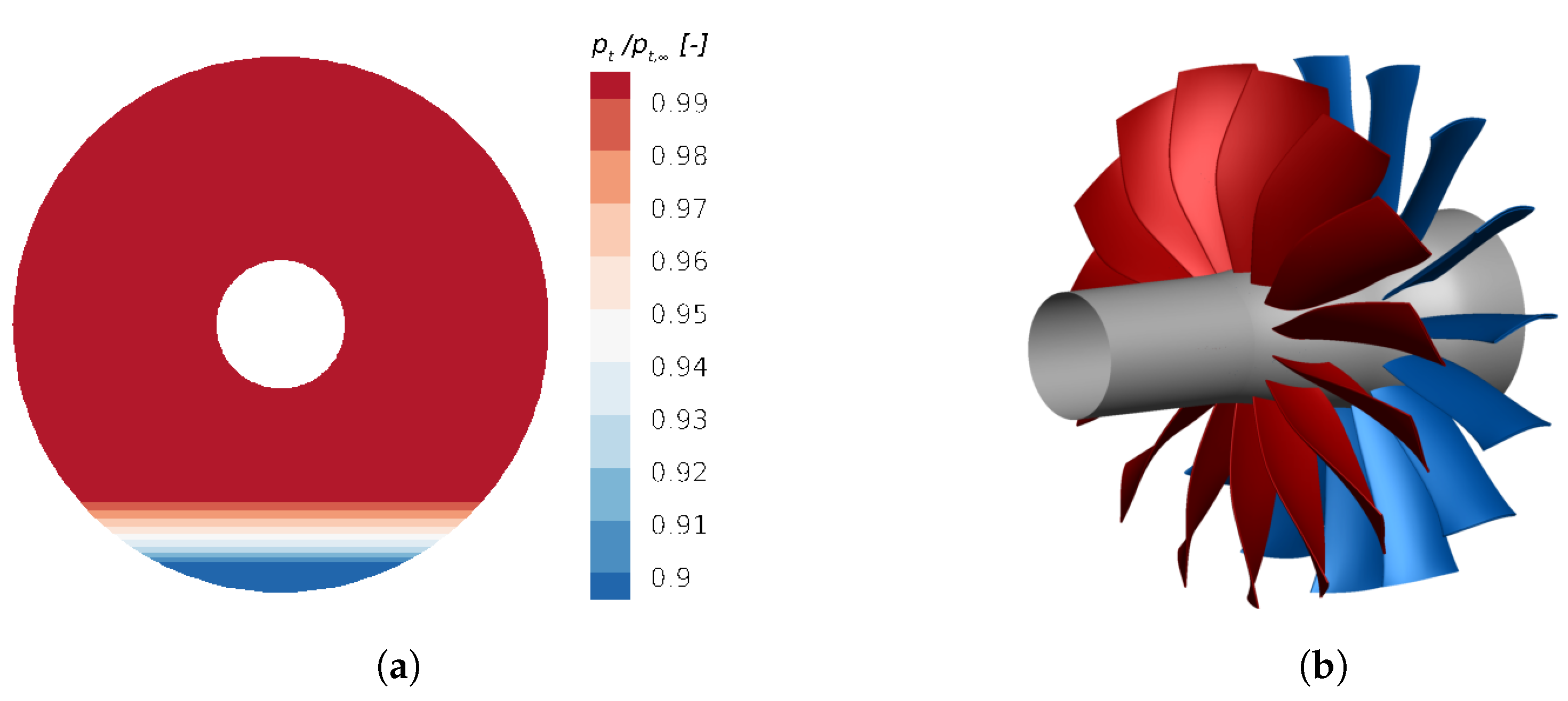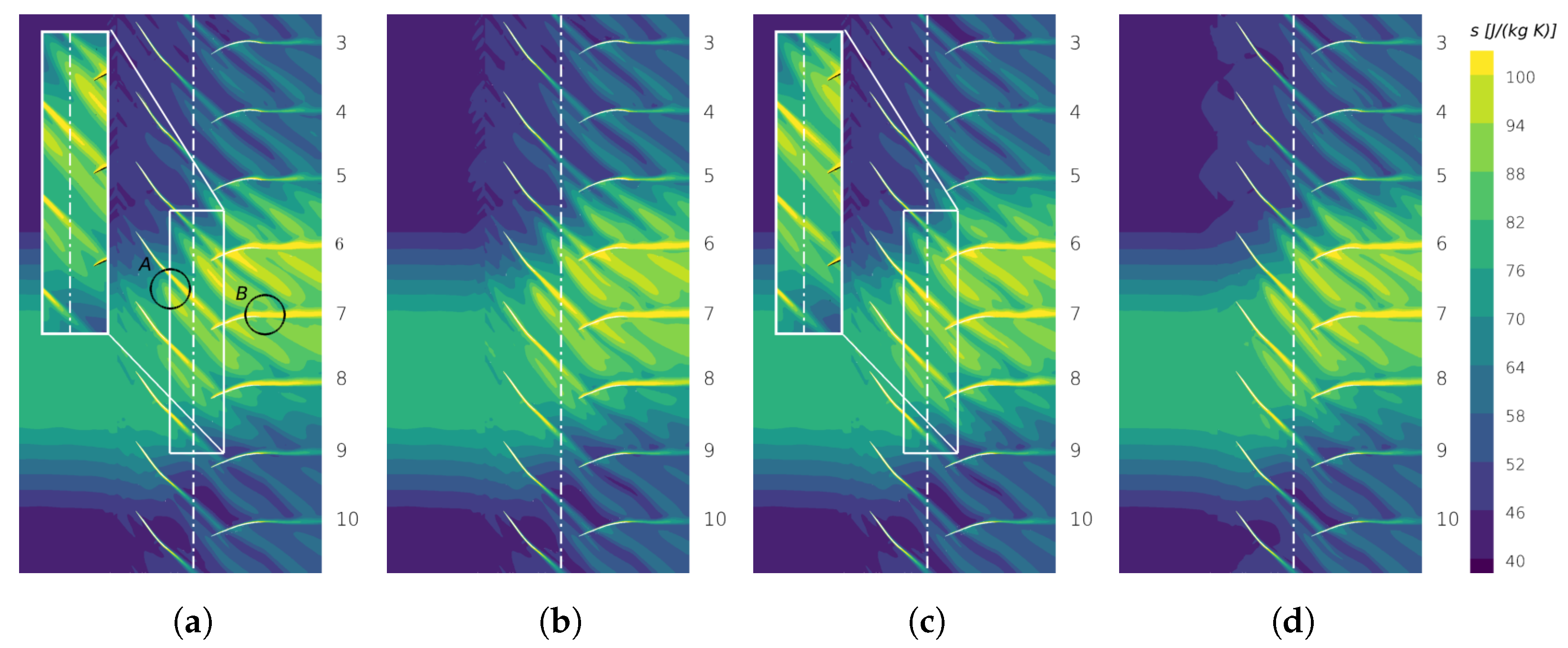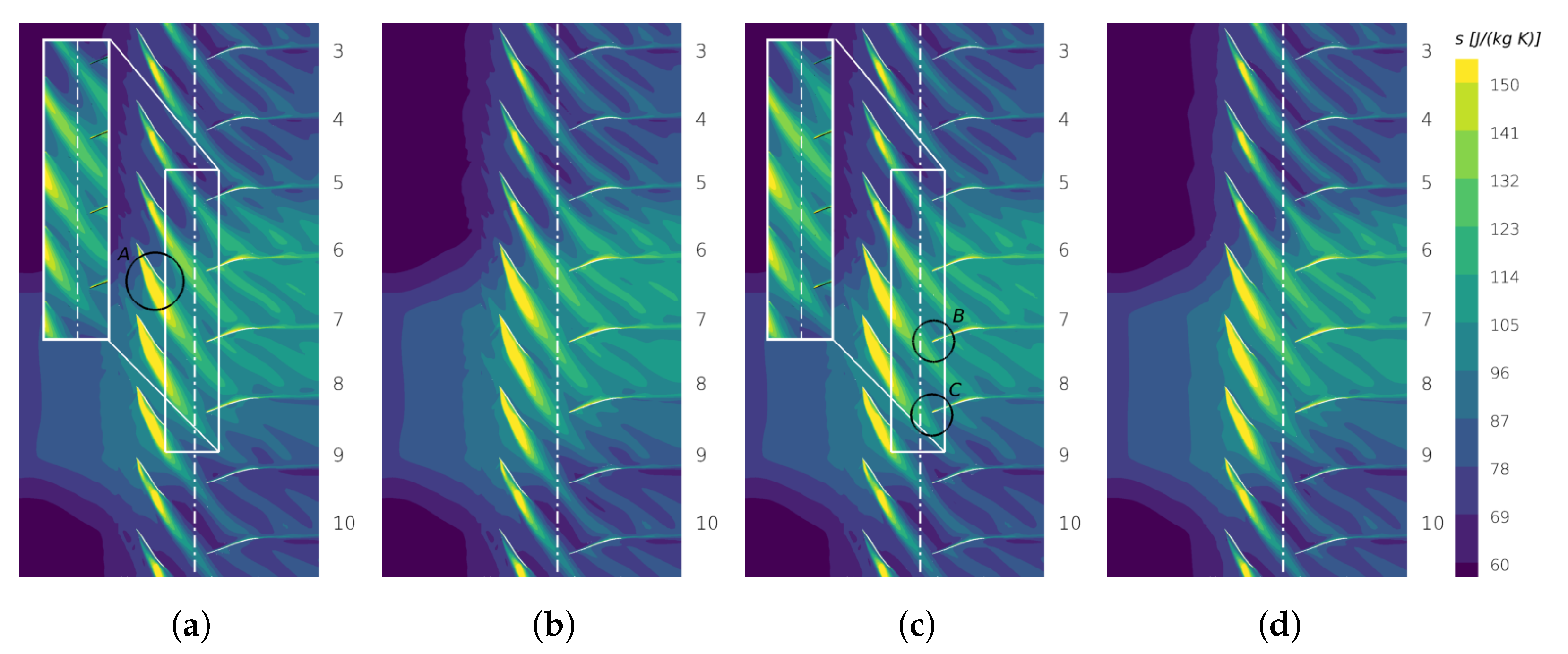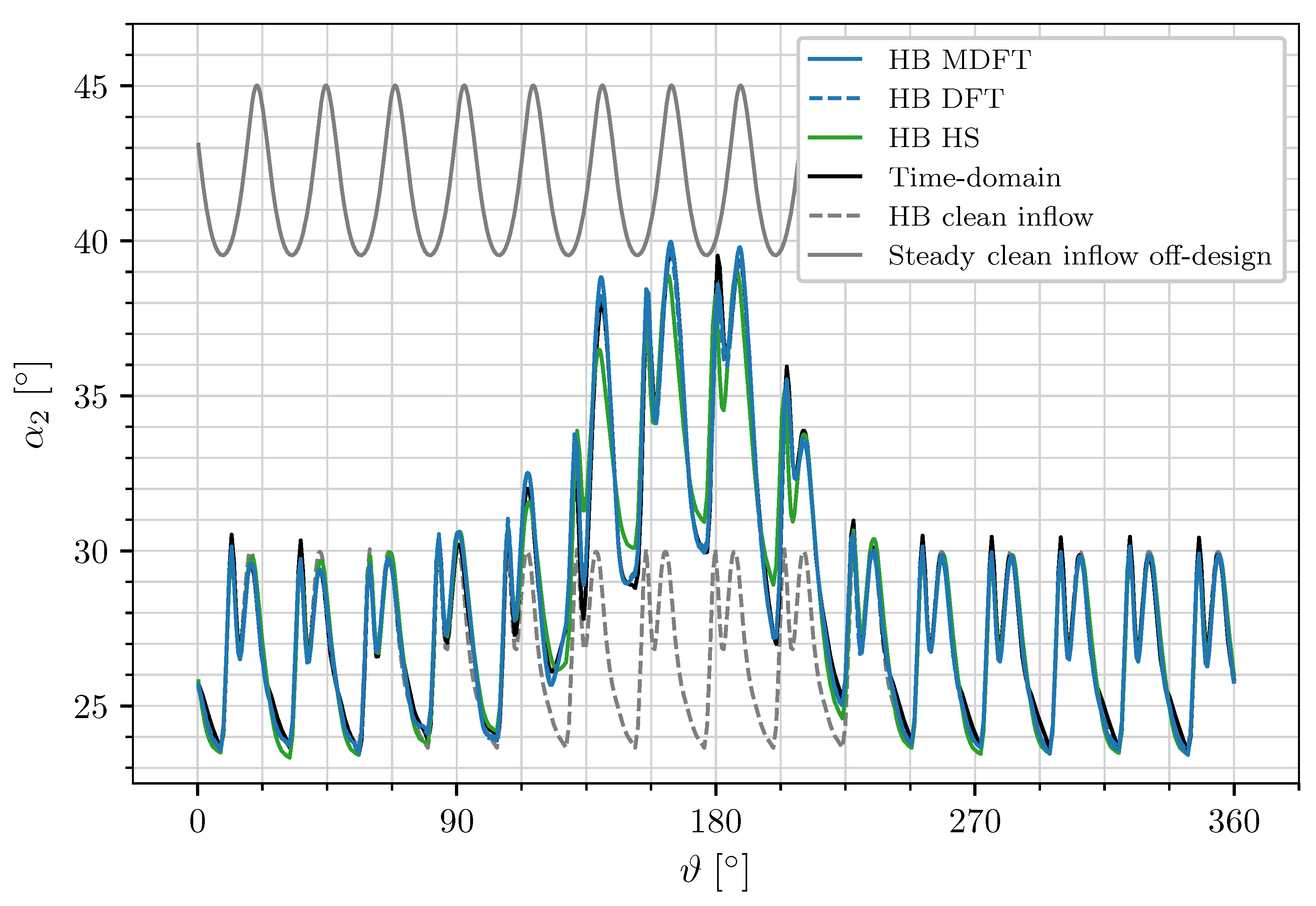Simulation of Indexing and Clocking with a New Multidimensional Time Harmonic Balance Approach †
Abstract
1. Introduction
2. Numerical Method
2.1. Harmonic Balance Technique
2.2. Extension to Rotationally Asymmetric Flow
3. Application
Testcase Description
4. Results
4.1. Instantaneous Entropy Distribution
4.2. Analysis of the Flow in Front of the Stator
4.3. Analysis of Fan Performance
4.4. Computational Costs
5. Conclusions
Author Contributions
Funding
Institutional Review Board Statement
Informed Consent Statement
Data Availability Statement
Conflicts of Interest
Nomenclature
| B | Blade count |
| i | Square root of |
| DFT | Discrete Fourier transform |
| HB | Harmonic balance |
| HS | Harmonic set |
| K | Highest harmonic |
| Set of harmonic indices | |
| k | Harmonic index |
| L | Number of passages |
| Set of passage indices | |
| l | Passage index |
| Passage periodicity | |
| M | Number of time dimensions |
| Ma | Mach number |
| MDFT | Multidimensional discrete Fourier transform |
| N | Number of sampling points |
| Vector of conservative flow variables | |
| Flow residual | |
| s | Entropy |
| T | Period |
| Set of sampling points | |
| t | Physical time, sampling point |
| Cylindrical coordinates | |
| Flow angle | |
| Pitch | |
| Interblade phase angle value | |
| Hyperphase | |
| Prefactor of Fourier transform | |
| Rotational speed | |
| Angular frequency | |
| (Inverse) Fourier transform | |
| Set of frequencies and interblade phase angles | |
| gcd | Greatest common divisor |
| Real part of a complex quantity | |
| Fourier coefficient | |
| Multidimensional quantity | |
| Base frequency index, time dimension index | |
| Base quantity |
References
- He, L.; Ning, W. Efficient approach for analysis of unsteady viscous flows in turbomachines. AIAA J. 1998, 36, 2005–2012. [Google Scholar] [CrossRef]
- Vasanthakumar, P. Three Dimensional Frequency-Domain Solution Method for Unsteady Turbomachinery Flows. Ph.D. Thesis, Durham University, Durham, UK, 2003. [Google Scholar]
- Hall, K.C.; Thomas, J.P. Computation of Unsteady Nonlinear Flows in Cascades Using a Harmonic Balance Technique. AIAA J. 2002, 40, 879–886. [Google Scholar] [CrossRef]
- McMullen, M. The Application of Non-Linear Frequency Domain Methods to the Euler and Navier-Stokes Equations. Ph.D. Thesis, Stanford University, Stanford, CA, USA, 2003. [Google Scholar]
- Guedeney, T.; Gomar, A.; Gallard, F.; Sicot, F.; Dufour, G.; Puigt, G. Non-uniform Time Sampling for Multiple-frequency Harmonic Balance Computations. J. Comput. Phys. 2013, 236, 317–345. [Google Scholar] [CrossRef]
- Frey, C.; Ashcroft, G.; Kersken, H.P.; Voigt, C. A Harmonic Balance Technique For Multistage Turbomachinery Applications. In Proceedings of the ASME Turbo Expo 2014, Düsseldorf, Germany, 16–20 June 2014. GT2014-25230. [Google Scholar]
- Subramanian, V.; Custer, C.H.; Weiss, J.M.; Hall, K.C. Unsteady Simulation of a Two-Stage Cooled High Pressure Turbine Using an Efficient Non-Linear Harmonic Balance Method. In Proceedings of the ASME Turbo Expo 2013, San Antonio, TX, USA, 3–7 June 2013. GT2013-94574. [Google Scholar]
- Junge, L.; Frey, C.; Ashcroft, G.; Kügeler, E. A New Harmonic Balance Approach Using Multidimensional Time. J. Eng. Gas Turbines Power 2021, 143, 081007. [Google Scholar] [CrossRef]
- Frey, C.; Ashcroft, G.; Kersken, H.P.; Schönweitz, D.; Mennicken, M. Simulation of Indexing and Clocking with Harmonic Balance. Int. J. Turbomach. Propuls. Power 2018, 3, 1. [Google Scholar] [CrossRef]
- He, L.; Chen, T.; Wells, R.G.; Li, Y.S.; Ning, W. Analysis of Rotor-Rotor and Stator-Stator Interferences in Multi-Stage Turbomachines. J. Turbomach. 2002, 124, 564–571. [Google Scholar] [CrossRef]
- Frey, C.; Ashcroft, G.; Kersken, H.P.; Schönweitz, D.; Mennicken, M. Simulation of Indexing and Clocking with Harmonic Balance. In Proceedings of the 12th European Conference on Turbomachinery Fluid dynamics & Thermodynamics ETC12, Stockholm Sweden, 3–7 April 2017. [Google Scholar]
- Shannon, C. Communication in the Presence of Noise. Proc. IRE 1949, 37, 10–21. [Google Scholar] [CrossRef]
- Becker, K.; Heitkamp, K.; Kügeler, E. Recent Progress in a Hybrid-Grid CFD Solver for Turbomachinery Flows. In Proceedings of the Fifth European Conference on Computational Fluid Dynamics ECCOMAS CFD 2010, Lisbon, Portugal, 14–17 June 2010. [Google Scholar]
- Lengyel-Kampmann, T.; Otten, T.; Schmidt, T.; Nicke, E. Optimization of an Engine with a Gear Driven Counter Rotating Fan Part I: Fan Performance and Design. In Proceedings of the 22nd ISABE Conference, Phoenix, AZ, USA, 25–30 October 2015. [Google Scholar]
- Gunn, E.J.; Hall, C.A. Aerodynamics of Boundary Layer Ingesting Fans. In Proceedings of the ASME Turbo Expo 2014, Düsseldorf, Germany, 16–20 June 2014. Volume 1A: Aircraft Engine; Fans and Blowers, V01AT01A024. [Google Scholar]
- Kim, H.; Liou, M.S. Flow Simulation of N2B Hybrid Wing Body Configuration. In Proceedings of the 50th AIAA Aerospace Sciences Meeting including the New Horizons Forum and Aerospace Exposition, Nashville, TN, USA, 9–12 January 2012. [Google Scholar] [CrossRef]
- Plas, A.; Crichton, D.; Sargeant, M.; Hynes, T.; Greitzer, E.; Hall, C.; Madani, V. Performance of a Boundary Layer Ingesting (BLI) Propulsion System. In Proceedings of the 45th AIAA Aerospace Sciences Meeting and Exhibit, Reno, NV, USA, 8–11 January 2007. [Google Scholar] [CrossRef]
- Orszag, S.A. On the elimination of aliasing in finite-difference schemes by filtering high-wavenumber components. J. Atmos. Sci. 1971, 28, 1074. [Google Scholar] [CrossRef]
- Frey, C.; Ashcroft, G.; Kersken, H.P. Simulations of Unsteady Blade Row Interactions Using Linear and Non-Linear Frequency Domain Methods. In Proceedings of the ASME Turbo Expo 2015, Montreal, QC, Canada, 15–19 June 2015. [Google Scholar]
- Kersken, H.P.; Ashcroft, G.; Frey, C. Nonreflecting Boundary Conditions for Aeroelastic Analysis in Time And Frequency Domain 3D RANS Solver. In Proceedings of the ASME Turbo Expo 2014, Düsseldorf, Germany, 16–20 June 2014. GT2014-25499. [Google Scholar]
- Schlüß, D.; Frey, C. Time Domain Flutter Simulations of a Steam Turbine Stage Using Spectral 2D Non-Reflecting Boundary Conditions. In Proceedings of the 15th International Symposium on Unsteady Aerodynamics, Aeroacoustics & Aeroelasticity of Turbomachines (ISUAAAT15), Oxford, UK, 24–27 September 2018. [Google Scholar]
- Schlüß, D.; Frey, C. Time Domain Implementation of a Spectral Non-Reflecting Boundary Condition for Unsteady Turbomachinery Flows. In Proceedings of the 24th ISABE Conference, Canberra, Australia, 22–27 September 2019. [Google Scholar]
- Wilcox, D.C. Reassessment of the Scale-Determining Equation for Advanced Turbulence Models. AIAA J. 1988, 26, 1299–1310. [Google Scholar] [CrossRef]
- Junge, L.K. A New Harmonic Balance Approach Using Multidimensional Time. Ph.D. Thesis, Ruhr-Universität Bochum, Universitätsbibliothek, Bochum, Germany, 2023. [Google Scholar] [CrossRef]
- Cumpsty, N. Compressor Aerodynamics; Number Bd. 10 in Compressor Aerodynamics; Krieger Publishing Company: Malabar, FL, USA, 2004. [Google Scholar]
- Denton, J.D. The Calculation of Three-Dimensional Viscous Flow Through Multistage Turbomachines. J. Turbomach. 1992, 114, 18–26. [Google Scholar] [CrossRef]
- Fidalgo, V.J.; Hall, C.A.; Colin, Y. A Study of Fan-Distortion Interaction Within the NASA Rotor 67 Transonic Stage. J. Turbomach. 2012, 134, 051011. [Google Scholar] [CrossRef]









 |
Disclaimer/Publisher’s Note: The statements, opinions and data contained in all publications are solely those of the individual author(s) and contributor(s) and not of MDPI and/or the editor(s). MDPI and/or the editor(s) disclaim responsibility for any injury to people or property resulting from any ideas, methods, instructions or products referred to in the content. |
© 2024 by the authors. Licensee MDPI, Basel, Switzerland. This article is an open access article distributed under the terms and conditions of the Creative Commons Attribution (CC BY-NC-ND) license (https://creativecommons.org/licenses/by-nc-nd/4.0/).
Share and Cite
Junge, L.; Frey, C.; Ashcroft, G.; Kügeler, E. Simulation of Indexing and Clocking with a New Multidimensional Time Harmonic Balance Approach. Int. J. Turbomach. Propuls. Power 2024, 9, 17. https://doi.org/10.3390/ijtpp9020017
Junge L, Frey C, Ashcroft G, Kügeler E. Simulation of Indexing and Clocking with a New Multidimensional Time Harmonic Balance Approach. International Journal of Turbomachinery, Propulsion and Power. 2024; 9(2):17. https://doi.org/10.3390/ijtpp9020017
Chicago/Turabian StyleJunge, Laura, Christian Frey, Graham Ashcroft, and Edmund Kügeler. 2024. "Simulation of Indexing and Clocking with a New Multidimensional Time Harmonic Balance Approach" International Journal of Turbomachinery, Propulsion and Power 9, no. 2: 17. https://doi.org/10.3390/ijtpp9020017
APA StyleJunge, L., Frey, C., Ashcroft, G., & Kügeler, E. (2024). Simulation of Indexing and Clocking with a New Multidimensional Time Harmonic Balance Approach. International Journal of Turbomachinery, Propulsion and Power, 9(2), 17. https://doi.org/10.3390/ijtpp9020017







